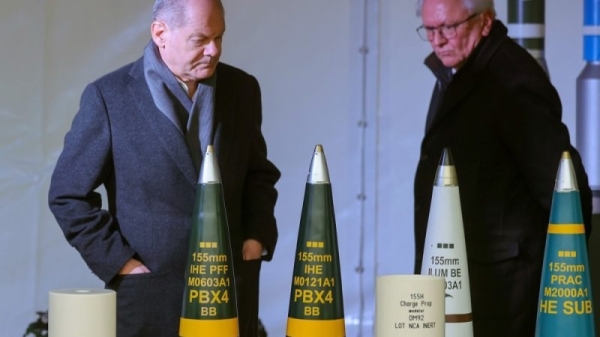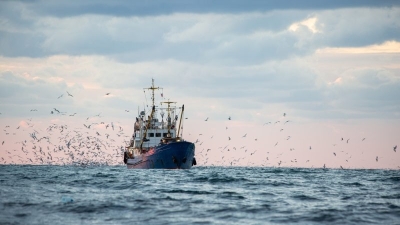Where does the EU stand on its ammunition pledge to Ukraine?

One year on since EU member states promised to send Ukraine one million rounds of ammunition within 12 months, only half have been delivered, other channels to supply Kyiv outside the bloc’s framework, have also equally struggled to meet this target.
As Kyiv faces a potential summer Russian offensive with military officials warning Ukraine could soon be outgunned ten to one, Ukrainian officials have stepped up calls to speed up deliveries.
The EU’s ammunition plan in which EU countries pledged to send one million rounds of complete ammunition, including powder and explosives, within twelve months, is financed by a special fund for military deliveries: the European Peace Facility (EPF).
It aims to help Ukraine’s armed forces push back Russia’s troops, giving the arms industry a long-term perspective on orders, and encouraging investment in production capacity.
Ammunition of 155-mm and missiles must either originate from existing stockpiles – the so-called track one – or be secured via joint procurement deals primarily within the EU’s industry and Norway – track two.
The EU’s ammunition pledge does not consider ammunition delivered under other programmes, such as bilateral deliveries, or multilateral schemes such as the Czech ammunition initiative.
Half delivered
“When it comes to the three-track approach, based on the information received from member states so far, they have delivered half of the objective set under the ammunition initiative,” a European Commission spokesperson told Euractiv.
The updated figures confirm the estimation EU foreign policy chief Josep Borrell gave in January, counting donations from available arsenals and individual and joint procurement.
According to the European External Action Service (EEAS), only 500,000 ammunition rounds were procured and delivered under the bloc’s ammunition plan in the past twelve months, half of the promised amount.
But the EEAS pointed out that EU member states will have delivered “more than one million rounds of ammunition to Ukraine before the end of the year” adding that figures keep evolving.
The deadline to place orders via the European Defence Agency (EDA) or lead nation framework for countries to be reimbursed by the EPF was October.
But all contracts passed after and deliveries from stockpiles beyond that point are not considered under that figure.
Difficult target to reach
These conditions have made the delivery of ammunition rounds under this scheme slower than anticipated for two reasons.
First, the EU’s defence industry had limited production capacity and received few orders.
Second, some governments did not ask for the reimbursement of their orders and deliveries from the EPF, which therefore cannot be counted as part of the plan.
It became evident just after a few months, that the target would be missed.
German Defence Minister Boris Pistorius criticised the plan in the autumn and was the first person to publicly say that the EU would not fulfil its promise.
“The right question to be asked would be whether one million was ever a realistic goal,” said Pistorius.
Borrell had also confirmed it would be difficult to reach this target due to unavailable production capacity, stating in November that only one-third, around 300,000 rounds, was delivered.
In January, the figures in the pipeline of orders and manufacturing increased to 630,000, said Borrell, striking a more positive note.
For the Estonians, who originally came up with the joint acquisition proposal, the numbered promise was a way to keep EU member states accountable and pressurise industry to increase production capacity.
For Kusti Salm, permanent secretary of the Estonian defence ministry, “without [this promise], the dominating narrative would have been the sort of classical defeatism,” he told reporters last month.
“Some people might say that the initiative did not hit the target. It’s a valid argument, but it’s only a valid argument if you don’t have a relative scale,” he added.
Classified information
The breakdown of which rounds originated from the existing stockpiles or procurement is classified.
A part of the overall figure was purchased via framework contracts organised by the European Defence Agency (EDA), offering member states facilitated options for joint procurement for four different artillery systems or their components: France’s Caesar, Poland’s Krab, Germany’s Panzerhaubitze 2000, and Slovakia’s Zuzana.
EDA has signed a total of 60 framework contracts, amounting between €1 billion to €1.5 billion – but by mid-April, signed deals totalling around €350 million.
Only seven countries used these, while the EDA is currently in talks with three additional EU member states.
The “first deliveries are starting in the next couple of weeks,” an EU official told Euractiv, estimating orders to reach above 70,000 rounds for either Ukraine or replenishing national arms stocks.
It is also unclear how many rounds of ammunition countries have jointly purchased outside the EDA framework.
Germany, France and Sweden for example led a group of countries, to jointly procure from European factories.
Accounting tricks
All in all, it is difficult to say how many ammunition rounds, and of which kind Ukraine has received in the past twelve months, considering that most data is confidential.
This is to avoid giving Russia an idea of Kyiv’s war-fighting capabilities, and its allies’ quantity of production and supply capacity.
In total Europeans “already delivered one million rounds,” an EU official stated back in February.
That said, the 500,000 rounds delivered under the ammunition plan where member states are reimbursed by the EPF does not include everything Kyiv has received from Europeans in the past year.
In addition, it has also received bilateral donations, which are not counted under the EPF scheme.
It also does not take into account the ammunition sourced under the Czech initiative. According to the country’s president, more than 800,000 pieces of available ammunition were identified to be funded.
The Czechs are looking at ways to “broaden” this scheme, one diplomat told Euractiv, potentially including other kinds of weapons.
Ukraine also procures directly from European defence businesses. According to an EU official, Kyiv bought at least 340,000 rounds since last March.
While the Europeans may not have delivered via the EU programme, the slow pace of deliveries has shone a spotlight on the bloc’s industrial war production capacity, which increased by 40% for ammunition since the beginning of the war.
“In less than 10 months, we have increased our production capacity for artillery ammunition to one million loaded shells per year. And we will be increasing this to two million by 2025,” Internal Market Commissioner Thierry Breton said last month.
Read more with Euractiv



